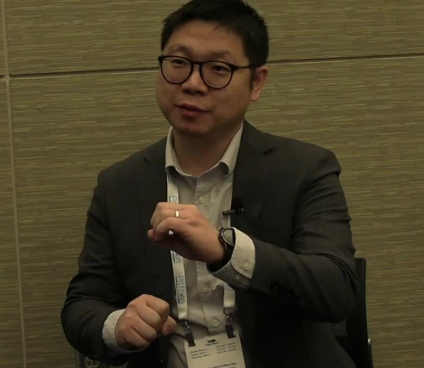
LCGC Interviews
Latest News

Latest Videos

More News

In the final section of our interview with Christopher Pohl, he imparts knowledge to the next generation of aspiring separation scientists.

In this interview segment, we sat down with Chris Palmer of the University of Montana to discuss his talk, as well as the evolving role of electrokinetic chromatography in applications areas such as environmental analysis.

In this interview clip, Katelynn Perrault Uptmor, an assistant professor of chemistry at the College of William & Mary, in Williamsburg, Virginia, discusses winning the Emerging Leader in Chromatography Award and her upcoming talk tomorrow.

In this penultimate section of our interview with Christopher Pohl, he reflects on the history of chromatography, sharing what he deems the most important moments in the field.

LCGC International spoke to Paul-Albert Schneide and Oskar Munk Kronik about the development and application of a novel two-step workflow—mass filtering (MF) combined with multivariate curve resolution (MCR)—for extracting clean mass spectra from trace-level compounds in LC×LC–HRMS data.

Here is some of the most popular content posted on LCGC International this week.

In this third part of our interview with Christopher Pohl, he tells us about his most treasured accomplishments from throughout his storied career.

In this second part of our interview with Christopher Pohl, we learn about the mentors Pohl turned to throughout his career, and the important teachings he took from them.

In this video interview, Emanuela Gionfriddo, Daniel Armstrong, and Nicholas Snow preview their talks at Pittcon, as well as give their opinions about what topics they hope to explore more at the conference.

In this first part of our interview with Christopher Pohl, he discusses the 2025 LCGC Lifetime Achievement Award, and what this means to him.

LCGC International spoke to Amanda Patrick, associate professor at Mississippi State University, about her research exploring mass spectrometry (MS) applications in ionic liquid analysis.

In a continuation of our Inside the Laboratory interview with Chris Reddy, we asked him about the recent documentary, “Out of Plain Sight,” that featured him and his team’s research.

An investigation into fluoroelastomer watch bands has revealed high levels of perfluorohexanoic acid (PFHxA), a short-chain per- and polyfluoroalkyl substance (PFAS). LCGC International spoke to Professor Graham Peaslee from the University of Notre Dame about his team’s study using liquid chromatography tandem mass spectrometry (LC–MS/MS) and PFHxA's potential for dermal absorption, and the subsequent environmental and health impacts.

In the second part of this edition of “Inside the Laboratory,” Christopher Reddy of Wood Hole Oceanographic Institution discusses why comprehensive two-dimensional gas chromatography is the optimal technique for investigating complex mixtures of organic chemicals in the environment.

In this edition of “Inside the Laboratory,” Christopher Reddy of Wood Hole Oceanographic Institution discusses his laboratory’s work investigating oil spills and uncovering dichlorodiphenyltrichloroethane (DDT) deposits on the ocean floor. This interview is part one of three of our conversation with Reddy.

At the Recent Advances in Food Analysis (RAFA) conference in 2024, LCGC International sat down with Stefan van Leuwen of Wageningen Food Safety Research to discuss his research, which addresses emerging challenges in circular food production, focusing on the risks posed by pollutants when waste and by-products are repurposed in food systems.

At ISC 2024 in Liverpool, United Kingdom, LCGC International interviewed Kelly Zhang of Genentech about her work analyzing new drug modalities, such as mRNA, oligonucleotides, peptides, and cell and gene therapies.

Throughout 2024, the editors of LCGC International attended chromatography conferences across the globe. Below, you’ll find a sampling and overview of our conference coverage from the year.

This article highlights a curated selection of the most popular GC-related content, with a focus on the diverse applications of the technique, as featured in LCGC.

LCGC International sat down with Jose Bernal to discuss his latest research in using pyrolysis gas chromatography–mass spectrometry (Py-GC–MS) and other chromatographic techniques in studying microplastics in food analysis.

LCGC International sat down with Giorgia Purcaro of the University of Liege to discuss the impact that solid-phase microextraction (SPME) and comprehensive multidimensional gas chromatography (GC×GC) is having on food analysis.

Here is some of the most popular content posted on LCGC International this week.

Following the HPLC 2024 Conference in Denver, Colorado, LCGC International spoke with Anne Marie Smith of ACD/Labs about the new ICH Q14 guidelines and how they impact analytical scientists and their work.

The 54th International Symposium on High Performance Liquid Phase Separations and Related Techniques (HPLC 2025) will be held from Sunday through Thursday, 15–19 June 2025, in Bruges, Belgium. LCGC International spoke to the Scientific Committee to find out what’s in store.

LCGC International spoke with Jim Gearing, Associate Vice President of Marketing, Agilent Gas Phase Separations Division; Massimo Santoro, Group Business Development Director at Markes International; Ed Connor, GC Product Manager at Peak Scientific; and Bruce Richter, Vice President of Research & Development at Restek Corporation.








